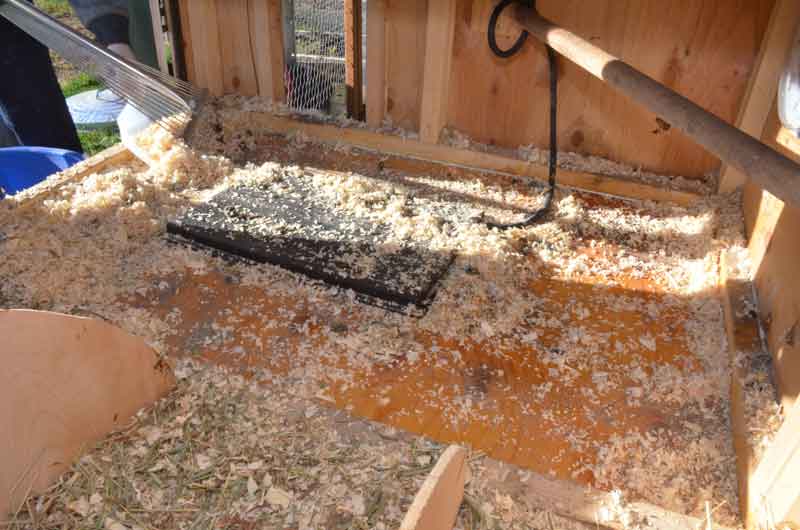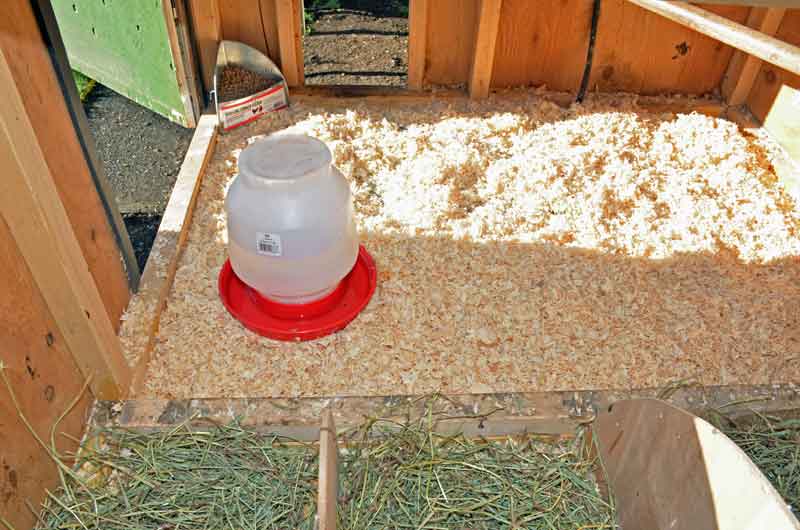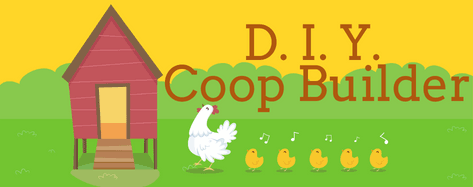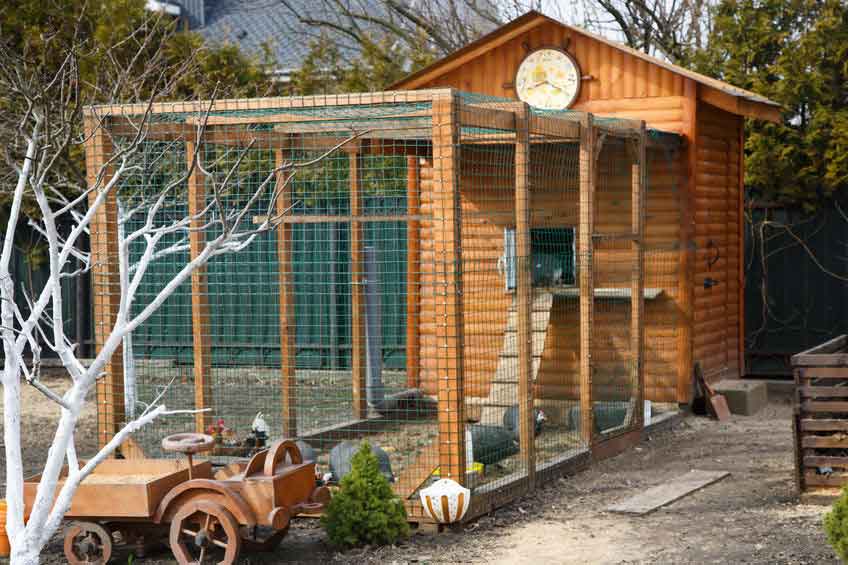If you’re wondering how much work it is to maintain a chicken coop year round – we have bad news.
To keep your chickens safe, secure and healthy, good housing is of paramount importance. The chicken coop should be solid enough to protect them from predators and all kinds of weather. It should also be raised off the ground. This ensures the hens are not living in a cold and damp environment which is not beneficial to their health.
Clean and healthy
Only healthy chickens lay healthy eggs. To keep chickens that are not only healthy but happy as well, requires time and regular cleaning. This is a chore that many people can do without. It puts off many people from having any pet, not just chickens. However, if you do it regularly, it’s a job that won’t take up very much of your time.
If you do have chickens, the main job every day is to provide your flock with clean food and water. Although pelleted feeds can stay in a food hopper for up to a week, it can go moldy very quickly. Especially if it is allowed to get wet. If this should happen the birds can become very sick through consuming the moldy food.
Common cleaning tasks
There are two cleaning jobs that need to be done on a regular basis:
- the regular cleaning out of the chicken coop
- the regular cleaning out of the coop run
How often these need to be done solely depends on how many chickens you have, the size of the chicken coop, and run in which they live.
Chickens pass the majority of their droppings during the night. Ideally, cleaning should be done in the morning. Then the hens can spend their waking hours in a clean environment, not a dirty one.

Frequency of cleanings
A small chicken coop ideally should be cleaned every day, or every other day at most. A larger one should be cleaned at least once every week. During hot summer months or winter, when the chickens tend to stay inside more, it may need cleaning more often.
If the floor litter looks dirty and wet and the coop smells of ammonia then it is well overdue a good cleaning.
By cleaning the chicken coop every day even if it is just under the roosting area, you will prevent the air inside the coop from becoming toxic. Stale chicken droppings produce ammonia, so a build up of droppings will consequently mean a build up of ammonia. This can put your chickens at an increased risk of disease, respiratory and eye problems.
Not only that, but dirty and wet floor litter and bedding are an excellent breeding ground for all kinds of parasites. This is bad for the health of the entire flock. Therefore cleaning out the coop is an important task that should not be neglected.
The cleaning process
To clean the coop properly, you will need some specific equipment, such as:
• A large bucket
• A stiff bristle sweeping brush or small rake
• A small shovel
• A paint scraper
• Rubber gloves
• Spray bottle (for spraying disinfectant mix into cracks)
• Poultry disinfectant
• Lice and Red Mite Powder or Diatomaceous earth (Diatom powder)
To begin make sure that all the chickens are safely in the chicken run and cannot get out. Then start by cleaning all the perches. If they are removable, clean them more thoroughly. The feeders and water containers should also be cleaned and freshened by using separate brushes or sponges. Do not use the same brush or sponge to clean the feeder and water containers to avoid cross-contamination.
Other considerations
The nest boxes need to be cleaned out and any bedding that is soiled or smells bad needs to be removed. Any bedding from the nest boxes that is unsoiled can be saved and re-laid on the floor of the chicken coop once it has been cleaned. A paint scraper works well in removing any droppings that are dried on to any areas. Finally, have a good sweep around to make sure that any remaining dust and debris is collected and removed.
During periods of nice weather the doors of the hen house can be left open for a while to give it a good airing and to let the sunlight in. Be careful to not let any chickens escape while they’re open. Once this has been done, replace the perches and dropping boards before adding clean, fresh bedding. Finally, replace the feeders and water containers.

Bedding options
There are a number of products available to use as bedding. As long as what you use is dust free, absorbent and provides some insulation you can use whichever one you prefer that suits your pocket and which works with the cleaning system you choose. Personally, I prefer natural elements such as soft wood shavings for the floor and Timothy hay for the nesting boxes.
There are two basic cleaning systems – spot cleaning and the deep bedding system. The deep bedding system is popularly used for people who have a lot of chickens as their chicken coop will only need cleaning out once a year. It is also beneficial for smaller coops during the winter when extra heat is needed inside the coop to help keep the chickens warm against the freezing temperatures outside.
Pine shavings
A good layer of pine shavings is laid over the floor of the coop and instead of cleaning it out and replacing it every week it is simply raked over and then a fresh layer of shavings is added over the top of it. By regularly doing this the floor litter will begin to build a compost layer which will produce heat.
This layer will also produce good bacteria which will eat any unhealthy microbes produced by the chicken’s droppings. This will also help reduce the risk of disease. The build up of droppings the coop will require good ventilation to keep the air fresh so that it does not smell of ammonia or cause respiratory problems.
Other bedding options
A small chicken coop housing a small number of birds should be spot cleaned every day. However, if you think the bedding looks overly wet and dirty then remove it all and replace it. If you wouldn’t like to live in it, then the chances are your chickens won’t like it either.
Straw is commonly used in nesting boxes and on the floor, particularly if you own a large flock. It isn’t very absorbent and can become damp quickly requiring it to be changed more frequently. The straw can also bring unwanted pests such as lice and mites into the chicken coop if it is lengthy. Chopped straw can be used for spot cleaning and is less likely to have lice and mites in it.
Rapeseed straw can also be used for spot cleaning. Not only is it absorbent, insulating and can be composted, but it also smells nice and is one of the most economical and cheapest beddings available if cost is an issue. Wood shavings are a popular choice with poultry keepers as not only are they cheap but they are absorbent as well.
Freshen up the smell
Nothing smells fresher in a chicken coop, or any pet enclosure, than wood shavings and straw. It just says clean. The shavings, though, must come from a soft wood tree, such as pine. The must also be dust extracted to prevent respiratory problems for your chickens. It is also important that cedar shavings are not used anywhere in the chicken coop or the run as these can be extremely toxic to chickens.
Shredded hemp is becoming more popular with poultry keepers. Although it is a more expensive option, it does have the the additional benefit of being a fly repellent. It is a lot more absorbent and has better insulating qualities than wood shavings. Chopped or shredded cardboard can be used as it is easy to clean out as well as being absorbent, free from dust and it will compost down easily. Shredded paper can also be used but it is neither insulating nor absorbent and can be messy in bad weather.
Seasonal cleaning
A full cleaning of the coop should be done in early spring to ensure that it is clean before the red mite season begins. Do this on a warm, dry day early in the morning so that everything has plenty of time to dry thoroughly. A thorough spring clean ensures that everything can be thoroughly scrubbed with a poultry disinfectant that will help eliminate red mites and other parasites.
While you are cleaning, keep an eye open for any piles of grey dust that resemble cigarette ash as this is could be sign that red mites are present in your coop. Should these be found, this should be addressed without delay.
During the warm summer months the coop should be regularly treated for red mites and lice. These are extremely common and are hard to get rid of once they have infested your coop. Therefore, after every clean sprinkle any cracks anywhere in the coop, especially at the end of perches, with powder specifically for the use of treating red mite and lice.
Deep cleaning tactics
To give the chicken coop a thorough cleaning it should be taken apart as much as possible. Remove as many internal parts you can, including feeders, water containers, perches and nesting boxes.
The next step is to scrape off any dried droppings and remove all the bedding as you would during a weekly clean of the coop. Once this is done, mix up the poultry disinfectant as directed on the label and scrub the floor, perches, nest boxes, etc with it using a stiff bristled scrubbing brush. Spray it into all the cracks and crevices that you can find as red mites like to hide away in these tiny little spaces.
If you have a hose handy, the coop can be thoroughly hosed down before it is scrubbed with the disinfectant and then used to rinse it off again.
Once this has been done everything needs to be left to dry in the sunshine. The UV rays from the sunlight will also kill bacteria and pathogens. The longer you can leave everything to dry, the better as everything must be fully dried before it is put back into the coop. At this point, Mite powder or Diatomaceous earth can be sprinkled around the coop to prevent any mites or lice from reinfesting.

Late Summer / Early Autumn considerations
It is also good practice to do another thorough clean towards the end of the autumn. A thorough cleaning can get rid of any parasites, lice or mites before the cold winter weather sets in.
Late summer or early autumn is the time to start checking the roof of the chicken coop for any leaks where rain may get in. Check for any holes and gaps that may allow drafts.
Chicken coops made of timber will breathe and move with the changing seasons. With the correct ventilation. your hens will be living in the healthiest environment possible throughout the year. They will not be suffocating during the heat of the summer months. The freezing the cold of winter will be less dangerous as well.
Brand new coops shouldn’t have any leaks or holes. If you have had your coop for five years or more, the chances are that parts of it may have begun to rot. If this happens, these areas will need repairing as soon as possible.
Winter maintenance
During the winter only the mesh vents should be left uncovered for adequate ventilation during the day. They should be closed when the temperature drops or if the weather is particularly bad. Always prevent rain or snow from entering the coop.
Heat lamps may seem like a good idea to help keep the coop warm in winter. They can also bring the added risk of fire if they are not installed or maintained properly. Added heat is best achieved with extra bedding and curtailing unwanted drafts. Heat loss and if they get too cold they may stop producing eggs or become sick.
The chicken run needs love too
Once the chicken coop is clean, it is time to turn your attention to the chicken run. If the run is permanently fixed into one place, cleaning it is a necessary job. It can be a haven for all manner of illnesses if not kept clean. The smaller the size of the run the more often it will need cleaning out. If the chicken coop and run are mobile, it’s a simple process of moving everything to a fresh, clean area.
Chickens like to dig and scratch around, so the flooring of the run needs to allow them to do this. If the base of the run is just soil, the chicken droppings can simply be raked up once a week. Racking or turning the dirt is also beneficial.
Covering the floor
If you want a flooring that is less prone to getting muddy, it can be covered with either sand or hardwood chippings. This will help to make cleaning the run easier as well as minimizing odour. The use of a ground sanitizer will help to destroy any worm eggs that are left behind before the chickens get a chance to eat them and become ill.
Sand
Sand can be used in an outside run and has the advantage of being inexpensive and easy to clean. Since it cannot be composted, sand can be raked out and the clean sand reused. The droppings are left behind to be used for compost.
Wood chips
If you use wood chips, they need to be of a soft wood such as pine and only need raking over and a new layer added to them once or twice a year. Wood chips should not be confused with shredded bark which can and will get damp.
Bark
Whether in a bag or laid out in a chicken run, bark can become moldy causing respiratory infections. This happens when moldy bark releases spores into the air which may be inhaled or ingested by the chickens.
Gravel
Gravel can also be used in the run, however, many chicken keepers note that their chickens do not like walking on gravel. Wood shavings and straw are popular for use inside the chicken coop, but they are best avoided in a run. Wood shavings can become soggy and blow away completely if there is a strong wind blowing.
Structural considerations
Both the chicken coop and the run will need repair every now and then. While doing your weekly cleaning, inspect both the coop and the run to see if the weather, predators or the chickens themselves have caused any damage.
Pay special attention to the fencing around the coop and run. If any damage is found, it must be repaired. Predators will find any opening and use it to kill the chickens. You chickens are also pretty smart and will find the smallest opening to explore the world outside of the fence.
Seasonal Changes
Seasonal changes may also call for additional alterations due to temperature fluctuations. During the summer months, the run needs to have a completely shaded area so the chickens have somewhere cool to escape the heat of the sun. Water containers should be placed away from direct sunlight so the hens can cool off by drinking.
Any painting or wood treatment needed, should be carried out on a warm day. This allows the product to dry quickly and the chickens to return to their home before darkness falls. Hens should not be in the coop while it is being painted.
To allow your chickens to go out into the run during the winter months, rather than being shut up inside the coop all the time, the top and sides of the run can be covered in clear plastic. The cover will let sunlight increase the thermal warmth inside the run. The cover will also keep out any inclement weather such as heavy rain and snow.
Conclusion
Carrying out routine preventative maintenance on your chicken coop regularly will lessen your workload in the future. It will ensure the continuing good health of your chickens and their eggs.

